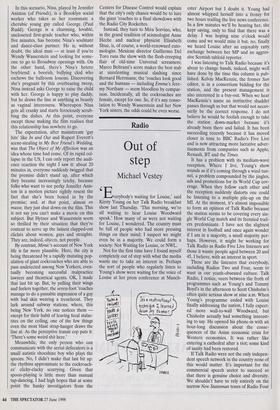Cinema
Mimic (15, selected cinemas)
Marriage a la mode
Mark Steyn
In The Object of My Affection, Britain's Nicholas Hytner (director of Miss Saigon and The Madness of George III) and Broad- way's Wendy Wasserstein (author of e Sisters Rosenzweig) address that perennial complaint of the single urban female: whY are all the best men gay? To which a grow" mg minority of women would riposte: even if they are, so what? The notion that a straight woman and a gay man are some- how the ideal couple is one of the more curious contemporary fantasies, one which Miss Wasserstein would seem idea* placed to explore. Almost all her stage work is a meditation on the frustrations, for women, of traditional heterosexual relationships, in the course of which some gay pal queens around the room being witty, sensitive and supportive. The trouble is, even as fantasy, the fae hag couple seems less an alternative to bor- ing suburban marriage and more an extreme version of it: the gal sits at home while the guy has sex with whomsoever he wants. Straight men might rightly wonder why chicks only extend this dispensation to gays — and anyway, in practice, most women who tiptoe down this primrose path wind up looking like pathetic masochists. Chaque a son gout, chaque a son gay. MY objection to this affection is not societal but cinematic: at the core of such relation- ships is an element of making do, not a quality useful to romantic comedy. In this scenario, Nina, played by Jennifer Aniston (of Friends), is a Brooklyn social worker who takes as her roommate a cherubic young gay called George (Paul Rudd). George is a charming, lovable, uncloseted first-grade teacher who, within five minutes, has become Nina's soulmate and dance-class partner. He is, without doubt, the ideal man — at least if you're Wendy Wasserstein and looking for some- one to go to Broadway openings with. On the other hand, there's Nina's hetero boyfriend: a boorish, bullying clod who eschews the ballroom lessons. Discovering she's pregnant by this overbearing twerp, Nina instead asks George to raise the child with her. George is happy to play daddy, but he draws the line at anything as beastly as vaginal intercourse. Whereupon Nina gets all cranky and starts ferociously .scrub- bing the dishes. At this point, everyone except those making the film realises that this relationship has nowhere to go.
The expectation, after mainstream 'gay hits' like In and Out and Rupert Everett's scene-stealing in My Best Friend's Wedding, was that The Object of My Affection was an idea whose time had come. Of its rapid col- lapse in the US, I can only report the audi- ence reaction the night I saw it: about 20 minutes in, everyone suddenly twigged that the premise didn't stand up, after which they became increasingly tetchy, because folks who want to see perky Jennifer Anis- ton in a motion picture rightly resent the fact that she's been boxed in by the premise; and, at that point, almost en masse, they just shut down on the film. This is not say you can't make a movie on this subject. But Hytner and Wasserstein seem so thrilled by their situation that they're content to serve up the lamest clapped-out clichés about women, gays and straights. They are, indeed, objects, not people.
By contrast, Mimic's account of New York life is far more plausible. Here, the city is being threatened by a rapidly mutating pop- ulation of giant cockroaches who are able to pass undetected among New Yorkers, even- tually becoming successful malpractice lawyers and theatrical agents. OK, I made that last bit up. But, by pulling their wings and feelers together, the seven-foot 'roaches manage to do a passable impression of a guy with bad skin wearing a trenchcoat. They lurk around subway stations, where, this being New York, no one notices them except for their habit of leaving fecal stalac- tites on the ceiling, one of the few things even the most blasé strap-hanger draws the line at. As the perceptive transit cop puts it: `There's some weird shit here.'
Meanwhile, the only person who can communicate with the aerial defecators is a small autistic shoeshine boy who plays the spoons. No, I didn't make that last bit up: the rhythms approximate to the cockroach- es' clicky-clacky scurrying. Given that spoon-playing is little more than manual tap-dancing, I had high hopes that at some point the hunky investigators from the Centers for Disease Control would explain that the city's only chance would be to lure the giant 'roaches to a final showdown with the Radio City Rockettes.
Instead, they turn to Mira Sorvino, who, in the grand tradition of seismologist Anne Heche and nuclear physicist Elisabeth Shue, is, of course, a world-renowned ento- mologist. Mexican director Guillermo Del Toro runs the show with the flesh-creeping flair of old-time Universal screamers; Marco Beltrami's score makes the best stab at unrelenting musical slashing since Bernard Herrmann; the 'roaches look good and the humans — including Emma's Jere- my Northam — seem bloodless by compar- ison. Incidentally, all the cockroaches are female, except for one. So, if it's any conso- lation to Wendy Wasserstein and her New York sisters, the odds could be even worse.



























































 Previous page
Previous page